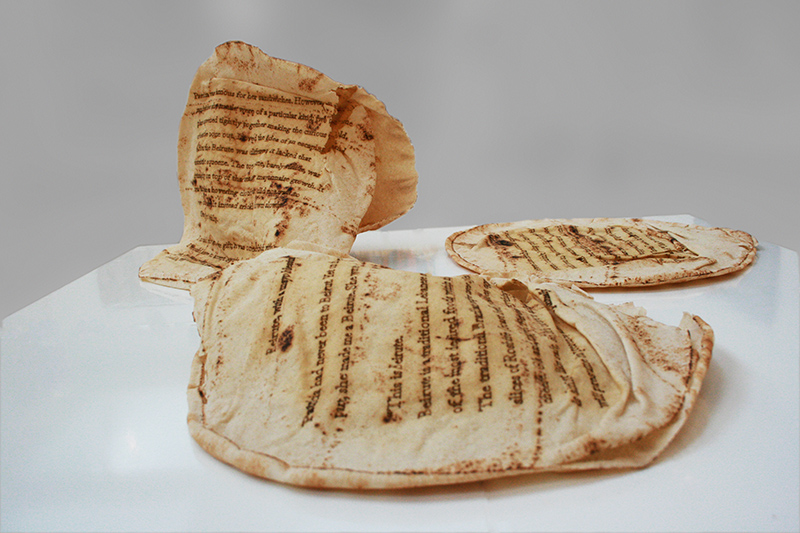Christine Kettaneh on language, Beirute and winning the Arte Laguna Art Prize
The puffed oval of Lebanese bread, Lebanon’s staple accompaniment to everything from meat, to hummus, to salad, has a mottled appearance. Its floury, off-white surface is interrupted by brown patches, where the oven has left its scorch marks on the dough. Amid these random markings, a pattern can be seen: regular, neatly inscribed symbols in parallel lines. In Christine Kettaneh’s A Beirute, with a mayo blessing, bread becomes the vehicle for reflection on a city, a blank sheet on which stories can be written.
The Lebanese artist was inspired to grill words into bread after a friend gave her a Beirute to eat, along with a letter explaining its name. The Beirute, she wrote, is a popular sandwich in Brazil, where it is considered to be a traditional Lebanese delicacy. Loaded with roast beef, tomatoes, eggs, lettuce and cheese, it is finished with an abundance of mayonnaise. “Everything takes mayo,” the letter read. “Mayo is almost like salt, so it’s ok not to add it to the recipe. People will assume its presence, almost spiritually.”
Kettaneh, who hates mayonnaise, found that the oozing condiment made her feel queasy, in a way that recalled the way she sometimes feels towards her city. “When I found out what the ingredients were, I felt like it’s a bit fictitious,” she recalls. “It’s not really Lebanese. So through writing I tried to make a connection between that sandwich and what the city Beirut is, comparing the spaces in the city with the spaces inside the sandwich.”
Using a laser, Kettaneh inscribed a series of short texts – including Patricia’s letter – onto sheets of thin Lebanese bread, to create the ephemeral A Beirute, with a mayo blessing. In April, the work won her the Arte Laguna Art Prize for sculpture and installation at an exhibition in Venice, where the jury chose just six winning artworks from among 120 entries from 44 countries. Kettaneh also won one of three Artist in Gallery prizes, netting her a solo show in New Delhi at Galleria Exhibit320.
A Beirute was originally inspired by the letter, but like most powerful artworks it contains multiple layers of symbolism. The use of bread, that staple food evocative of breadwinners, the breadline and Marie Antoinette’s supposed order to “let them eat cake,” contrasts poignantly with the high tech laser used to singe Kettaneh’s words into its surface.
Whether consciously or not, it also lends the piece an economic overtone. Perhaps this demonstrates the unconscious preoccupations of the artist. A faculty member in the Department of Fine Arts and Foundation Studies at Lebanese American University, Kettaneh has a BA and MA in finance and economics, as well as a BA in fine art from LAU and an MA from Central Saint Martins College of Arts and Design. The use of text forms a link between the piece and Kettaneh’s other projects, which have a common preoccupation with language.
“I like to explore the frailty, the weaknesses of language,” Kettaneh says, “because in the end language is something that humans have built, so I think staying aware that there is chaos behind language is important.”
Text forms an integral part of previous projects, including Echo, Soap Coins and Mute Melodies, which was exhibited at the Beirut Art Center in 2013, as part of their annual group show for emerging artists, Exposure.
For Kettaneh, artwork is not necessarily intended to be didactic, to send a message or to transmit an opinion. Instead, it’s a process of questioning and of forging connections.
“I feel like I’m trying to make connections through my art that I wouldn’t have reached if I were doing anything else,” she says. “It’s not totally direct, so it’s not like a formula. There is room for different interpretations and there is sometimes an enigma in the work… So there is a brain work that I expect from my viewers, but I think it doesn’t prevent people just appreciating it aesthetically. I like it to be intriguing, more than beautiful.”

